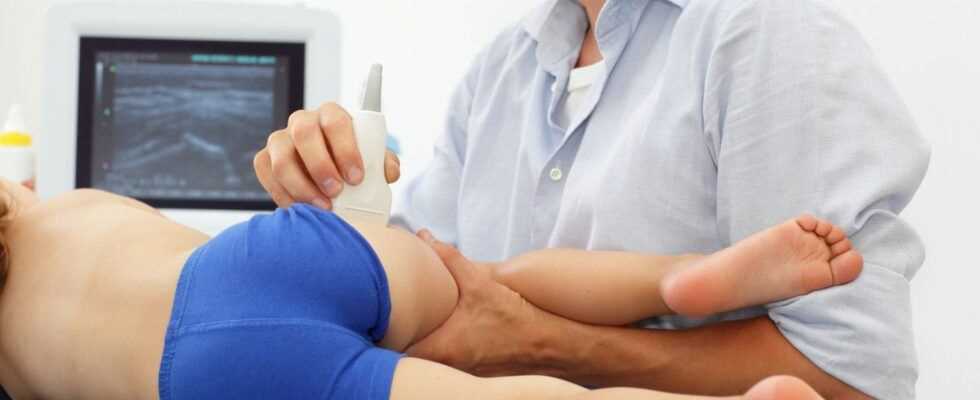The child limps and complains of hip pain. A runny nose can be the reason, especially after an infection. With a little rest, the pain will go away on its own after a few days. In adults, however, hip pain indicates inflammation or chronic disease.
- If a child's hip runny nose is suspected, the doctor can use ultrasound to look at the joint.
- © iStock.com/ndopack
Hip runny nose is relatively common in children of kindergarten and elementary school age. Each year around 76 out of 100,000 children are affected. Doctors refer to the disease as coxitis fugax ("volatile hip joint inflammation"). Children between the ages of two and ten can develop a runny nose. Four to seven year olds are particularly affected, boys more often than girls.
Laypeople sometimes speak of a runny nose in adults too. However, this is a purulent infection of the hip joint with significantly worse consequences. This joint inflammation can also affect babies.
At a glance:
Fluid in the joint with hip rhinitis
Coxitis fugax, on the other hand, proceeds without a purulent inflammation. Fluid has collected in the hip joint or the synovial membrane is swollen. That is what causes the pain. This hip runny nose often occurs after a viral infection – for example after tonsillitis, chickenpox or after a gastrointestinal infection. It is unclear why fluid subsequently collects in the hip joint in some children. However, a runny nose is a harmless childhood disease.
Symptoms of a runny nose: pain in the hip
The runny nose usually occurs suddenly. The child limps and has little desire to move. At the same time, he complains that his hip hurts. Some feel the pain up to their legs or say that they can no longer walk because of the pain. However, apart from this hip pain, the child appears fit and has a healthy appetite. This coxitis fugax only affects one side of the body. Around a third of the children affected also have an elevated body temperature.
Diagnosis of a runny nose
It is important for the doctor to distinguish the harmless cold from the hip from other, worse illnesses. He asks about previous infections and chronic illnesses. He also wants to know whether the child has behaved normally in the days before. It plays a major role in this, whether it might have had an accident and a broken bone as a result. Major sporting activities can also provide information about the cause of the pain.
It is good if the parents can observe the child closely and describe to the doctor as detailed as possible the situations in which the pain occurs and how the child expresses it.
Does the pain mainly occur in the morning after getting up or rather during the day?
Does movement make the pain better or worse?
Is the child limping? How strong?
Does the child forget the pain in between?
Does the child feel the pain more in the hip or in the leg / knee?
Does the child appear sick and weak or healthy overall?
Then the doctor will carefully try out whether the joint can move normally. To do this, he leads the leg into different positions. He can look at the joint with an ultrasound scan. The doctor recognizes changes in the joint and can classify them.
If he suspects pus in the joint, he must make a puncture (removal of fluid with a syringe) to be certain. After all, if left untreated, purulent coxitis endangers bone and cartilage growth. Therefore, in this case, the pus must be removed with joint irrigation. For a puncture, the doctor usually puts the child under anesthesia. With coxitis fugax, however, there is no pus in the joint.
If in doubt, a blood test can provide certainty that there are no increased levels of inflammation in the blood.
How long to take care of with a runny nose?
The main remedy for a runny nose is rest. However, the younger the person affected, the more difficult it is to keep up. Older children can protect the joint by using walking aids. However, younger children are usually overwhelmed by this. In addition, they often lack an understanding of the need for immobilization. That is why they are usually prescribed bed rest.
If the pain is severe, the doctor will also prescribe mild pain relievers. In most cases the child will feel fine after about five days and can then move around normally again. If the cold from the hip is particularly severe, it can take up to two weeks to heal. No long-term consequences or permanent damage are to be expected afterwards.
If the pain persists after two weeks, the child should definitely be referred to a doctor again. Because then there is the risk that another disease is the cause of the pain.
Prevent hip runny nose
You can't really prevent a cold from the hip. However, sick children should really take it easy and cure themselves thoroughly after a cold or a gastrointestinal infection. In the event of falls or collisions, parents should always consider the possibility of a broken bone and, if in doubt, contact a doctor.
Overall, a healthy life with plenty of exercise in the fresh air and balanced meals with lots of fruit and vegetables helps to strengthen the immune system. And a strong immune system can cope better with a hip cold too.


